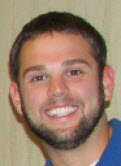An Idea Mapping Success Blogs Weblog
Part 3 of Introducing the First Idea Mapping Guest Blogger – Chris Kordick
24Aug2015 Filed under: Interviews Author: Jamie Nast Part 1 of this interview was posted on August 12, 2015 and part 2 was posted on August 15, 2015. This is the third of three posts about Chris Kordick who is the first Idea Mapping Guest blogger. Currently Chris is in his first year of med school at Lake Erie College of Osteopathic Medicine.
Part 1 of this interview was posted on August 12, 2015 and part 2 was posted on August 15, 2015. This is the third of three posts about Chris Kordick who is the first Idea Mapping Guest blogger. Currently Chris is in his first year of med school at Lake Erie College of Osteopathic Medicine.
Following are questions 8-10 of my interview with Chris:
8. What do you see as the benefits to using Idea Mapping?
There are many benefits, however, I’ll list the top three:
1. It allows the reader/student to actively copy down text, notes, and lectures, which allows them better recall of that information in the long run.
2. It provides the student with a chronological map of his/her study materials allowing them to study more efficiently—saving time and stress!
3. It allows the student to be colorful, creative, and fun while studying materials that are both interesting and dull. Let’s face it; every student must study something that is unappealing at some point in his or her career—why not make it creative and colorful?
9. Why do you prefer hand-drawn maps to using software?
I want to preface this by stating that software is not a bad tool, however, it is not for everyone! That being said I prefer hand drawn maps because “what the hand writes, the mind remembers.” Software programs are efficient, neat, and extremely powerful, but consciously copying things down in my own shorthand allows me to map out my notes in my mind as well as on paper. Many times during testing I was able to pull up snapshots of my maps because I could remember that I smudged a section in the upper right quadrant of the page, or that I wrote down a silly pneumonic next to a coffee stain. Those other environmental notes that appeared on the map acted as road signs for my recall.
10. Can you tell us a bit about your story and how you got to where you are today?
After graduating high school in Michigan, I knew that I wanted to study the sciences and attend medical school—I just didn’t know how God was going to make that happen. So I decided to have some fun with it and start off my collegiate career as a baseball player attending Benedictine University in Lisle, Illinois. About a year in, I had a severe injury that inhibited me from playing the rest of my college years, so I turned my focus from being a student-athlete to being a student-coach. Going through surgery and rehabilitation allowed me to share my experiences with other athletes and focus on things such as athlete health and injury prevention while coaching. It was during this time that I had seen my curiosity for sports medicine and exercise physiology ignite. My junior year I became the strength and conditioning intern for the baseball program and was able to take my talents into the weight room where I prepared our team for a season that ultimately allowed them to compete in the national tournament. During this time, I was able to use Idea Mapping to assist in my studies, as well as program development, to help me obtain a perfect grade point average, and create some insanely strong athletes. My senior year, I was asked to assist with multiple research projects through the university’s exercise physiology program. During the course of this research, I was able to present an abstract at the American College of Sports Medicine annual meeting and met some highly qualified, really awesome individuals. Now, after completing my bachelor’s degree and successfully taking the MCAT, I will be entering medical school this fall. It has been a wild ride thus far, but it’s only getting better!
Idea Mapping Blog
The purpose of this blog is to share idea mapping examples and related learning from my Idea Mapping, Memory, Speed Reading, and Certification Workshops. This blog is dedicated to my Certified Idea Mapping Instructors, my clients, Mind Mapping and Idea Mapping practitioners around the globe.
![[Ask]](http://ideamapping.ideamappingsuccess.com/IdeaMappingBlogs/wp-content/plugins/bookmarkify/ask.png)
![[del.icio.us]](http://ideamapping.ideamappingsuccess.com/IdeaMappingBlogs/wp-content/plugins/bookmarkify/delicious.png)
![[Digg]](http://ideamapping.ideamappingsuccess.com/IdeaMappingBlogs/wp-content/plugins/bookmarkify/digg.png)
![[Facebook]](http://ideamapping.ideamappingsuccess.com/IdeaMappingBlogs/wp-content/plugins/bookmarkify/facebook.png)
![[Google]](http://ideamapping.ideamappingsuccess.com/IdeaMappingBlogs/wp-content/plugins/bookmarkify/google.png)
![[MySpace]](http://ideamapping.ideamappingsuccess.com/IdeaMappingBlogs/wp-content/plugins/bookmarkify/myspace.png)
![[Slashdot]](http://ideamapping.ideamappingsuccess.com/IdeaMappingBlogs/wp-content/plugins/bookmarkify/slashdot.png)
![[Sphinn]](http://ideamapping.ideamappingsuccess.com/IdeaMappingBlogs/wp-content/plugins/bookmarkify/sphinn.png)
![[StumbleUpon]](http://ideamapping.ideamappingsuccess.com/IdeaMappingBlogs/wp-content/plugins/bookmarkify/stumbleupon.png)
![[Technorati]](http://ideamapping.ideamappingsuccess.com/IdeaMappingBlogs/wp-content/plugins/bookmarkify/technorati.png)
![[ThisNext]](http://ideamapping.ideamappingsuccess.com/IdeaMappingBlogs/wp-content/plugins/bookmarkify/thisnext.png)
![[Twitter]](http://ideamapping.ideamappingsuccess.com/IdeaMappingBlogs/wp-content/plugins/bookmarkify/twitter.png)
![[Webride]](http://ideamapping.ideamappingsuccess.com/IdeaMappingBlogs/wp-content/plugins/bookmarkify/webride.png)
![[Email]](http://ideamapping.ideamappingsuccess.com/IdeaMappingBlogs/wp-content/plugins/bookmarkify/email.png)
Leave a reply